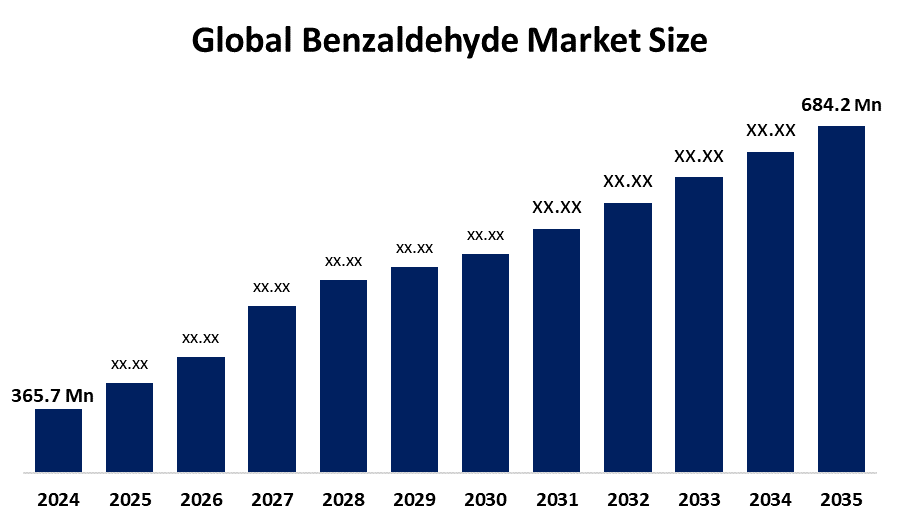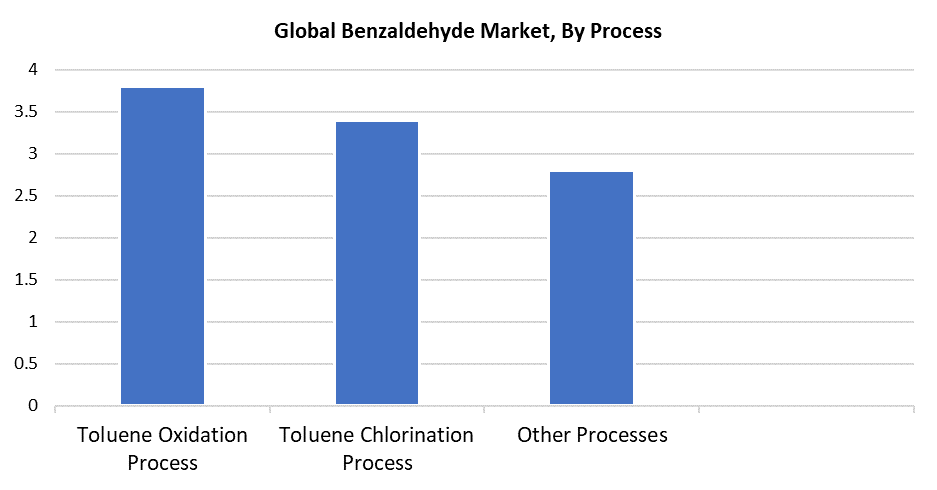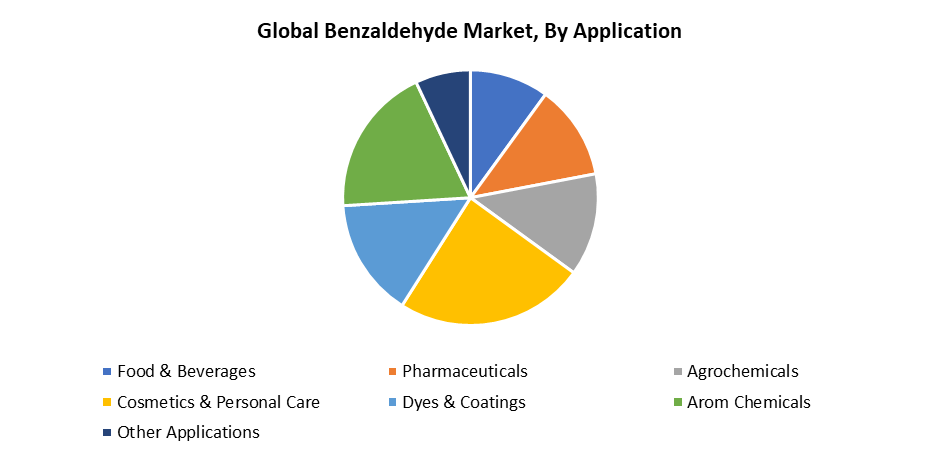Benzaldehyde Market Size & Trends
The Global Benzaldehyde Market Size was estimated at USD 365.7 Million in 2024 and is projected to Reach USD 684.2 Million by 2035, growing at a CAGR of 5.86% from 2025 to 2035. The market for benzaldehyde is expanding as a result of its numerous uses in a range of sectors, such as personal care, food and beverage, agrochemicals, and pharmaceuticals. One of the main drivers is the rise in demand for aromatic compounds, especially in tastes and fragrances.
Key Regional and Segment-Wise Insights
- In 2024, North America held the largest revenue share of over 38.26% and dominated the market.
- In 2024, the toluene oxidation method segment had the highest market share by process, accounting for 38.5%.
- In 2024, the cosmetics and personal care segment had the biggest market share by application, accounting for 24.7%.
Global Market Forecast and Revenue Outlook
- 2024 Market Size: USD 365.7 Million
- 2035 Projected Market Size: USD 684.2 Million
- CAGR (2025-2035): 5.86%
- North America: Largest market in 2024

The benzaldehyde market functions as a worldwide industry that produces, distributes, and sells the chemical compound benzaldehyde, which has an almond scent. The benzaldehyde market growth exists due to its diverse applications in agrochemical products along with flavor and perfume, and medicinal products. The unique almond scent makes benzaldehyde highly sought after by the fragrance and flavor industries because these sectors continue to expand their food flavorings and fragrant personal care product offerings. Benzoaldehyde serves as an essential component in soaps, lotions, fragrances, and other cosmetic products to enhance their final appeal. The substance benzaldehyde serves two important functions as a medicinal component and an agrochemical intermediate, which enables both rising agricultural production and pharmaceutical breakthroughs. The essential role of benzaldehyde within these growing sectors' supply chain continues to expand because of worldwide population expansion and changing buyer preferences for specialized chemical products.
Benzaldehyde market dynamics are greatly influenced by the cost and availability of raw materials, especially toluene. The volatility of feedstock prices affects both profitability and production expenses, leading firms to implement supply chain management and hedging strategies together with strategic sourcing methods for financial risk reduction. The market shows promising growth potential through the implementation of environmentally friendly and sustainable production methods. The industry focuses on eco-friendly synthesis methods and renewable resource development because of rising environmental regulations and consumer preference for sustainable products. The market position of manufacturers improves through research investments that develop efficient production methods while reducing environmental impact to achieve regulatory compliance. The benzaldehyde industry will experience stable growth together with technological advancements because of its focus on sustainability.
Process Insights

The toluene oxidation method segment led the benzaldehyde market with a 38.5% revenue share in 2024 and is predicted to maintain its leadership position throughout the forecast period. Established technology forms the basis of this approach, which ensures both operational efficiency and stable dependability. The enhanced production process enables mass production while effectively meeting the growing demands of the agrochemical, pharmaceutical, and fragrance sectors. Manufacturers can offer affordable prices because they can obtain toluene at low costs and implement process improvements that reduce expenses. The industry shift toward sustainability has led to the toluene oxidation process demonstrating reduced environmental effects compared to other methods. The combination of these factors maintains its market dominance while driving steady market growth.
The toluene chlorination process sector plays a major role in the benzaldehyde market because it directly converts toluene into benzaldehyde in an efficient way. Manufacturers opt for this procedure because toluene remains affordable and easily accessible to the market. The pharmaceutical industry, together with flavoring and fragrance sectors, needs this process to meet their growing demand for premium benzaldehyde. The chlorination process remains practical for use today, even though new technologies have emerged specifically for facilities that use it in established legacy manufacturing operations. The demonstrated effectiveness and stable, high-quality product output of this market segment ensure its ongoing growth will match evolving consumer needs.
Application Insights

The cosmetics and personal care sector accounted for 24.7% of total market revenue in 2024, because of the global increase in personal care product needs. Benzaldehyde serves as an essential ingredient in soap production, lotion manufacturing, fragrance development, and skincare formulation because of its characteristics, such as almond aroma and preservative effects. The worldwide increase in disposable incomes, together with rising consumer knowledge about hygiene and grooming practices, fuels the demand for scented personal care products. The expansion of wellness and beauty markets within developing countries serves as a major factor for segment growth. During the forecast period, benzaldehyde will maintain its role of enhancing product aroma and stability, which leads to its growing market demand in cosmetics and personal care products among consumers who want top-quality scented products.
Aroma chemicals represent a fundamental component of the fragrance industry since benzaldehyde produces almond-scented fragrances that enhance household products, personal care products, and perfumes. The increasing popularity of both natural and synthetic perfumes stems from customers seeking unique and attractive scents. The application of benzaldehyde in beverage and food flavorings enables it to serve broader consumer needs, which expands its market potential. Product safety and quality awareness among customers drive producers to create complex scent combinations, which increases market demand. During the forecast period, the aroma chemicals segment will show one of the fastest growth rates in the benzaldehyde market because customers want customized and innovative smell profiles that ensure consistent revenue expansion.
Regional Insights
The North American benzaldehyde industry dominates worldwide because of strong market requirements from food and beverage industries, alongside personal care, pharmaceutical, and agricultural sectors. The region's established chemical industrial infrastructure ensures high-quality production and drives continuous innovation. The United States leads global benzaldehyde consumption because its advanced healthcare system and extensive food processing industry require this compound for flavorings and medications. The Canadian and Mexican markets maintain stable contributions to the expanding sectors of preservatives and fragrance compounds. The robust regulatory frameworks protect sustainability alongside safety measures as they respond to consumer demands for clean-label and environmentally friendly products. The North American market will maintain its growth trajectory because of ongoing research and development investments combined with rising consumer knowledge during the projection period.
U.S. Benzaldehyde Market Trends
The benzaldehyde market in the United States experiences the highest growth rate across North America because of its prominent food industry. Food products, including baked goods, beverages, and confections, use benzaldehyde as an essential ingredient because it provides a distinctive almond flavor and scent. Businesses use the United States' advanced research and development facilities to create innovative food and beverage product formulations that deliver unique and appealing flavor profiles. The expanding demand for new products with natural tastes drives the increasing use of benzaldehyde. The pharmaceutical and personal care industries continue to drive market growth. All factors combine to position the United States as a major development engine for the benzaldehyde market during the forecast period.
Asia Pacific Benzaldehyde Market Trends
The expanding pharmaceutical industry across Asia Pacific, which has strong manufacturing capabilities, serves as the primary factor driving the region's significant benzaldehyde market growth. The expanding need for benzaldehyde in agrochemicals, personal care products, and medicines drives this growth. The region improves its competitive position through cost-effective manufacturing, which results from fast industrialization and increasing chemical production investments. Specialist applications from South Korea and Japan create substantial market value for the industry. The expanding economy alongside increasing urbanization in developing markets supports growing consumer requirements. Multiple factors combine to generate enduring growth potential, which establishes Asia Pacific as an essential market with emerging value chains throughout the forecast period.
Europe Benzaldehyde Market Trends
The European benzaldehyde market will experience substantial development during the forecast period because of increasing requirements from the pharmaceutical and cosmetics, and fragrance chemical industries. To meet strict European safety and sustainability standards, manufacturers boost their production facilities to address the rising demand, specifically for high-purity bio-based benzaldehyde derivatives. The industry maintains its consumption levels through continuous innovation, along with increasing consumer knowledge about product transparency, which drives sales in Germany, France, and the UK. The region's sustainability commitment encourages the development and adoption of environmentally friendly benzaldehyde products. The European benzaldehyde market achieves stronger global market participation through regulatory alignment and specialty chemical focus, which drives continuous innovation-based, stable growth.
Key Benzaldehyde Companies:
The following are the leading companies in the benzaldehyde market. These companies collectively hold the largest market share and dictate industry trends.
- LANXESS AG
- Emerald Performance Materials, LLC
- Axxence Aromatic GmbH
- Gujarat Alkalies and Chemicals Limited
- Valtris Specialty Chemicals
- Emerald Kalama Chemical
- Kadillac Chemicals Pvt. Ltd.
- Shimmer Chemicals Pvt. Ltd.
- Ganesh Benzoplast Ltd.
- Taile Chemical Industry Co. Ltd.
- Wuhan Dico Chemical Co., Ltd.
- Others
Recent Developments
- In April 2024, at the cosmetic worldwide show in Paris in April 2024, LANXESS announced the launch of its portfolio of preservatives, multipurpose flavors, and perfumes for cosmetics and personal care products, as well as oral care solutions. Sodium benzoate, which is extremely sustainable, is used in this product. The Purox S Scopeblue is a climate-friendly substitute for the well-known product, Purox S, which is sodium benzoate that is nature-identical and easily biodegradable. To distinguish its products that have a CO2 footprint that is at least 50% lower than that of conventional products or that use at least 50% sustainable raw materials, LANXESS utilizes the Scopeblue brand label.
- In May 2023, LANXESS AG's U.S. facility has expanded its ability to manufacture benzyl alcohol. The expansion aims to support the current North American clients in maintaining their growth.
Market Segment
This study forecasts revenue at global, regional, and country levels from 2020 to 2035. Spherical Insights has segmented the benzaldehyde market based on the below-mentioned segments:
Global Benzaldehyde Market, By Process
- Toluene Oxidation Process
- Toluene Chlorination Process
- Other Processes
Global Benzaldehyde Market, By Application
- Food & Beverages
- Pharmaceuticals
- Agrochemicals
- Cosmetics & Personal Care
- Dyes & Coatings
- Arom Chemicals
- Other Applications
Global Benzaldehyde Market, By Regional Analysis
- North America
- Europe
- Germany
- UK
- France
- Italy
- Spain
- Russia
- Rest of Europe
- Asia Pacific
- China
- Japan
- India
- South Korea
- Australia
- Rest of Asia Pacific
- South America
- Brazil
- Argentina
- Rest of South America
- Middle East & Africa
- UAE
- Saudi Arabia
- Qatar
- South Africa
- Rest of the Middle East & Africa






